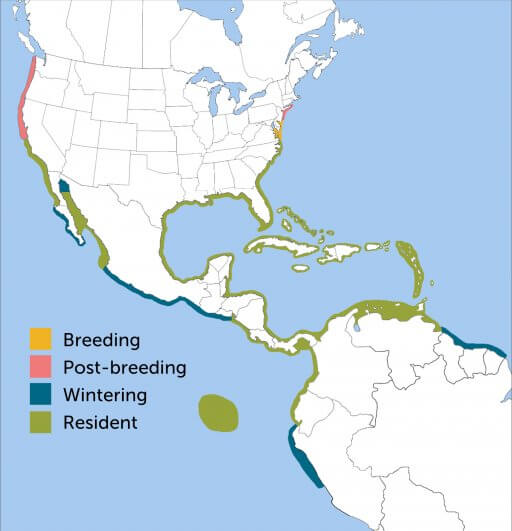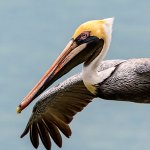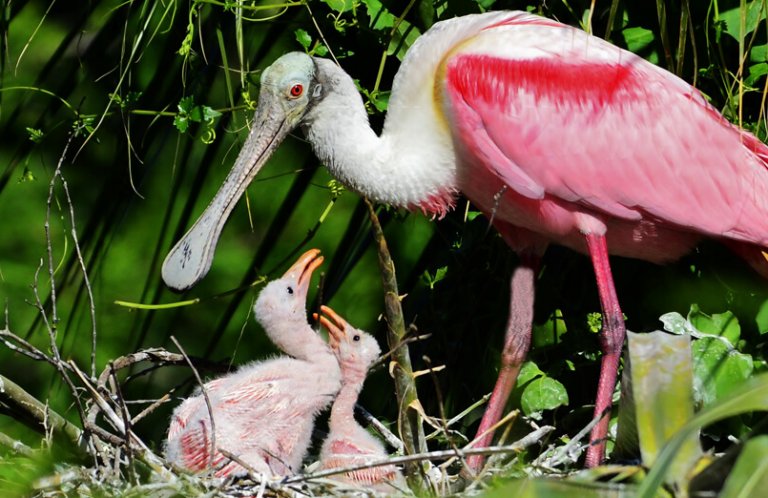About the Brown Pelican
“A wonderful bird is the pelican; his bill can hold more than his belly can,” begins the limerick by Dixon Lanier Merritt. And it's true — a pelican's pouch can hold up to three times more than its stomach. This multi-purpose structure serves as a scoop, cooling mechanism in hot weather, and as a trough for young pelicans, which retrieve food from their parents' pouches.
Although the Brown Pelican is the smallest of the world's eight pelican species, it's still a big bird at about four feet long (including the bill), with a six and a half-foot wingspan. The American White Pelican, North America's only other pelican species, is a foot longer and has a nine-foot wingspan, dimensions that help rank it, along with the California Condor, Trumpeter Swan, and Golden Eagle, as among North America's largest birds.
Driven almost to extinction twice — first by hunting and later by pesticides including DDT — the Brown Pelican today is a shining example of the success of conservation actions, including the Endangered Species Act and the work of the Environmental Protection Agency.
A Changing Climate
Unregulated shooting and pesticides were once the bane of many North American birds, including Brown Pelicans, Bald Eagles, and Peregrine Falcons. Declared Endangered in the 1970s, all three of these charismatic birds are now off the list of imperiled species, thanks to conservation legislation, public education, and decades of cooperation by a wide range of partners.
It's always good to reflect on this success, lest we take these birds for granted. Unfortunately, the Brown Pelican now faces other threats, and these dangers are growing. Pelicans, for example, may be flying into trouble caused by climatic changes, including rapid loss of coastline and nesting islands, inundation of estuaries, and the dramatic warming of coastal waters, which could lead to striking changes in fisheries upon which pelicans, and people, depend.
Songs and Sounds
Like many of its close relatives, including other pelicans, cormorants, and boobies, the Brown Pelican is not known to vocalize away from breeding sites. Nestlings, however, raise a racket through their squawking, especially as they beg for meals.
Breeding and Feeding
Life in the Flock
Brown Pelicans are gregarious birds, occurring in flocks much of the year. They begin to breed between three and five years old and nest in bustling colonies on the ground, amid low bushes and other vegetation, or in the tops of trees (primarily in Florida and in tropical parts of their range).
Ground nests may be a shallow depression or a large mound of soil and debris with a cup in the top. A treetop nest usually consists of reeds, grass, and straw heaped on a mound of sticks interwoven with the supporting tree branches.
For nest building, Brown Pelican pairs work cooperatively. The male delivers material to the female, who builds the nest. The female usually lays three white eggs, which both parents take turns incubating, mostly using their feet, essentially standing on them to shelter them from cold air or hot sun.

Like the hatchlings of other colonial nesting species such as the Wood Stork, pelican chicks begin life blind and featherless. Parents bring fish back to the young birds in their throat pouches, regurgitating the food, which the chicks snap up. In all, the Brown Pelican breeding cycle lasts about four and a half months, from the start of a pair's courtship to the young leaving the nest.
Dining by Diving
Brown Pelicans are primarily fish-eaters and require up to four pounds of prey per day. They use their keen eyesight to spot underwater quarry from the air, then plunge-dive from heights of up to 70 feet. The force of the birds' impact stuns small fish, enabling Brown Pelicans to scoop them up in their throat pouches. Air sacs beneath the skin cushion impacts and help the birds pop back to the surface. After they dive, Brown Pelicans tip their bills downward to drain water from the throat pouch, then throw their heads back to swallow their catch.
Like its cousin the American White Pelican, the Brown Pelican sometimes feeds by sitting on the surface and seizing prey with its bill. A bird will usually employ this feeding strategy only when a dense school of fish is close to the surface, or when the water is too shallow and muddy for plunge-diving. Brown Pelicans also steal food from other seabirds, pilfer bait fish or guts at piers, and eat invertebrates such as prawns.
Region and Range

Brown Pelicans usually breed in coastal colonies. This species occurs year-round along the shores of the Atlantic, Pacific, and Gulf of Mexico, from southern Maryland and Southern California down to northern South America. Brown Pelicans nest and winter across the Caribbean and also in the Galápagos Islands, off South America's Pacific coast. There are five subspecies, which differ in body size, plumage color, and breeding-season colors of the bill and area around the eyes.
After breeding season, this bird wanders well north of nesting areas, occurring up the entire U.S. West Coast, with small numbers even reaching southern British Columbia. On the Atlantic side, post-breeding birds regularly show up as far north as Long Island Sound in Connecticut. New York. By winter, though, Brown Pelicans are scarce at the top of the species' breeding range, while large numbers occur well to the south, in warmer waters.
Conservation
A Lasting Recovery?
The bird plume trade, which demanded dizzying numbers of dead birds to feed enduring fashion trends, almost brought an end to U.S. Brown Pelican populations and those of many other species, such as the Great Egret and Roseate Spoonbill, by the end of the 1800s. The U.S. National Wildlife Refuge System was established in 1903 to protect Brown Pelicans and other water birds from plume hunters. Conservation legislation including the Migratory Bird Treaty Act of 1918 also protected this and many other species.
After populations recovered from the shooting threat, the 1950s and 1960s ushered in chemical threats — when DDT and other pesticides came onto the scene, causing a second wave of population declines. Even if each fish in the pelicans' diet contained only small amounts of DDT, the birds, as top predators, ate many fish that, over time, caused toxins to build up in the birds' bodies. One result was that the birds produced thin eggshells that broke when parents were incubating, leading to a great loss of eggs and nests.

Help support ABC's conservation mission!
By 1970, the Brown Pelican was declared Endangered. Fortunately, in 1972, the Environmental Protection Agency banned the use of DDT in the United States. As a result, the level of DDT in the environment decreased in most areas, and the reproductive success of Brown Pelicans increased. Protection of nesting islands has also contributed to the species' recovery. In 2009, the Brown Pelican was taken off the list of endangered species.
By 1963, the Brown Pelican had vanished from Louisiana and was almost gone from Texas. Reduced pesticide contamination and reintroduction efforts helped bring the bird back to those two states. They are once again common in Texas and in Louisiana, where the species is the state bird. In recent decades, Brown Pelicans have expanded their breeding range from South Carolina north to Maryland, and started nesting in western Florida, Georgia, and Alabama.
Although the Brown Pelican responded well to conservation efforts, the species continues to face threats including climate change (as mentioned above) and habitat loss. This bird is also vulnerable to oil spills and large numbers can starve during sharp declines in food fish. Pelicans are also injured or killed by fishing line and hooks, and when they ingest plastics and other pollution. Disturbance at nesting colonies can cause nest abandonment.
Get Involved
Policies enacted by the U.S. Congress and federal agencies have a huge impact on seabirds. You can help shape these rules for the better by telling lawmakers to prioritize birds and bird-friendly measures. To get started, visit ABC's Action Center.
Plastics pose a deadly threat to seabirds around the world. You can help seabirds by reducing your daily use of plastics. To learn more and get started, visit our Plastics page.
American Bird Conservancy and partners are creating predator-free nest sites for vulnerable seabird species, reducing fishery impacts, and much more. This is a monumental undertaking, requiring the support of many, and you can help by making a gift today.






















































